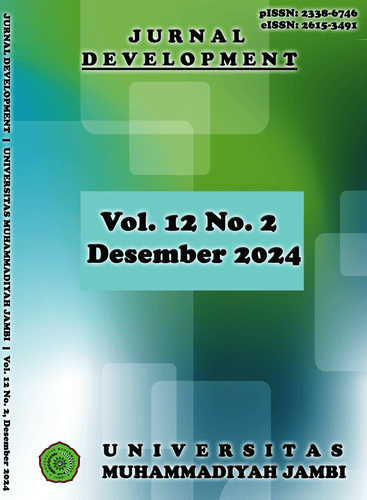Mengukur Kesiapan dan Optimisme Pelaku UMKM dalam Adopsi Teknologi Digital
Main Article Content
Abstract
Penelitian ini menggunakan metode deskriptif kualitatif dan kuantitatif yang bersifat ekploratif dengan objek penelitian adalah pelaku UMKM di Kota Jambi sebanyak 450 responden yang tersebar pada 11 kecamatan dan dibagi secara proporsional. Pengumpulan data dilakukan dengan metode observasi, wawancara dan dokumentasi tehnik purposive sampling dan dengan pendekatan random sampling. Penelitian ini menggunakan data primer dan data sekunder. Dimana data primer diperoleh melalui kuisioner, wawancara dan dokumentasi yang bersifat eksplorasi.
Untuk menjawab masalah pertama yaitu menganalisis kondisi sosial ekonomi pelaku UMKM di Kota Jambi dilakukan dengan analisis deskriptif kualitatif dengan pendekatan statistik. Selanjutnya untuk menjawab masalah kedua yaitu menganalisis berbagai faktor yang mempengaruhi persepsi dan optimisme penggunaan teknologi digital dengan menggunakan analisis Structural Equation Modeling (SEM) dan untuk masalah ketiga yaitu strategi kebijakan dalam meningkatkan literasi digital pelaku UMKM di Kota Jambi dilakukan dengan menggunakan analisis SWOT.
Downloads
Article Details
References
[2] Rahman SA, Taghizadeh SK, Ramayah T, Alam MMD. Technology acceptance among micro-entrepreneurs in marginalized social strata: The case of social innovation in Bangladesh. Technol Forecast Soc Change. 2017;
[3] Tiwasang, Pattanapong., Clark, Beth. G. How can rural businesses thrive in the digital economy? A UK perspective. Heliyon. 2022;8(10).
[4] Sunarsi, Denok. Implikasi Digitalisasi Umkm. Digitalisasi UMKM, 2020, 57.
[5] Ollerenshaw A, Corbett J, Thompson H. Increasing the digital literacy skills of regional SMEs through high-speed broadband access. Small Enterp Res. 2021;
[6] Tiwasang, Pattanapong., Clark, Beth. G. How can rural businesses thrive in the digital economy? A UK perspective. Heliyon. 2022;8(10).
[7] Warren M. The digital vicious cycle: Links between social disadvantage and digital exclusion in rural areas. Telecomm Policy. 2007;
[8] Townsend L, Sathiaseelan A, Fairhurst G, Wallace C. Enhanced broadband access as a solution to the social and economic problems of the rural digital divide. Local Econ. 2013;
[9] Tiwasing P. Social media business networks and SME performance: A rural–urban comparative analysis. Growth Change. 2021;
[10] Rafdinal W, Senalasari W. Predicting the adoption of mobile payment applications during the COVID-19 pandemic. Int J Bank Mark. 2021;
[11] Trinugroho I, Pamungkas P, Wiwoho J, Damayanti SM, Pramono T. Adoption of digital technologies for micro and small business in Indonesia. Financ Res Lett. 2022;
[12] Davis FD. Perceived usefulness, perceived ease of use, and user acceptance of information technology. MIS Q Manag Inf Syst. 1989;
[13] Rokhim R, Wulandari P, Mayasari I. Small medium enterprises technology acceptance model: A conceptual review. International Journal of Business and Society. 2018.
[14] Nugroho MA. Impact of Government Support and Competitor Pressure on the Readiness of SMEs in Indonesia in Adopting the Information Technology. In: Procedia Computer Science. 2015.
[15] Nugroho MA, Susilo AZ, Fajar MA, Rahmawati D. Exploratory Study of SMEs Technology Adoption Readiness Factors. In: Procedia Computer Science. 2017.
[16] Lorente-MartÃnez J, NavÃo-Marco J, Rodrigo-Moya B. Analysis of the adoption of customer facing InStore technologies in retail SMEs. J Retail Consum Serv. 2020.

